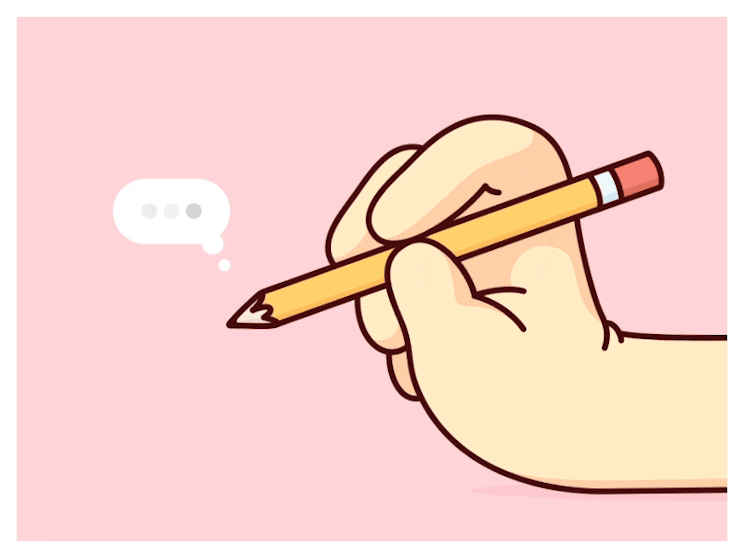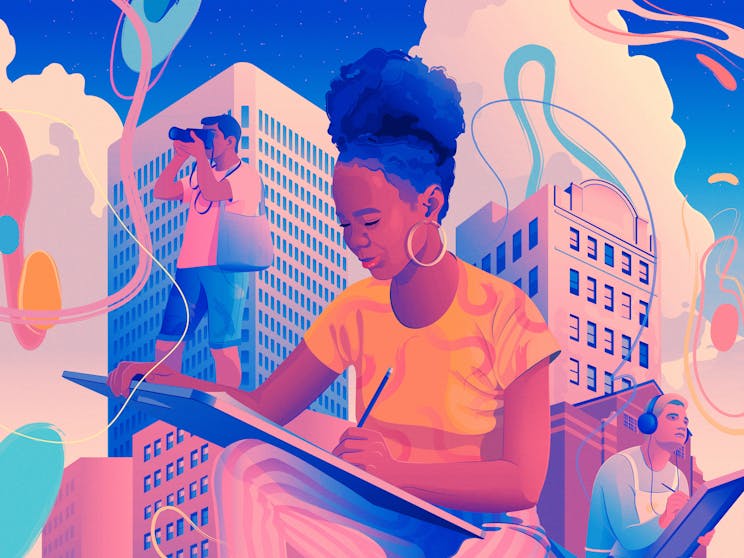learn how to draw 3d rooms
Education
A Beginner's Guide to Learning 3D Design & Illustration
Everything you need to get started in 3D pattern and illustration. Learn the right 3D tools to apply, where to learn, and the best industries for y'all to explore.
![]()
January 05, 2022
Learn Design
3D design isn't every bit scary as yous think! In this beginner's guide, designer and teacherRoman Klčo explains how to start learning 3D, the right tools to utilise, and the all-time industries for you to explore based on your background.
What started decades ago as a cut-edge engineering science that transformed many industries is now a user-friendly design tool that's more available than always.
Today, when y'all open Dribbble's homepage, you'll come across tons of beautiful 3D designs. 3D is a very convenient style for designers to create illustrations and visual content for their layouts, web designs, and digital products. But it doesn't end there. A whole industry has emerged in the past few years that heavily depends on the apply of 3D somewhere in the pipeline. Whether it's new digital production interfaces, automotive designs for virtual dashboards, smart home interfaces, or VR and augmented reality, 3D is there.
"There's however a huge demand for 3D designers and this demand only continues to grow."
But even with its popularity, the 3D job market doesn't feel saturated in any way. On the contrary, there's nonetheless a huge need for 3D designers and this need only continues to abound. Fifty-fifty your refrigerator has enough calculating power to run a uncomplicated 3D engine, which means the awarding opportunities have exploded. This in parallel drives the development of pattern tools, and so what was once only possible using proprietary 5-effigy software and hardware, tin can exist now washed in a web browser. Literally.
Permit'due south accept a quick look at what actually happens nether the hood in 3D design.
How 3D design & illustration works
If you lot think about it, 3D design has a lot in common with photography. Of form, there's the very technical aspect of modeling objects—but like to photography, you need a scene to place these objects on, you need to prepare up a virtual camera that takes the shot, and you need to create proper lighting. And as you can imagine, limerick plays a huge role here.
Luckily, equally a designer, you're probably already familiar with a lot of these skills. This means yous tin can take all of this knowledge, and directly employ it within a new tool.
There are multiple approaches to modeling objects based on the software you use. Each approach includes the manipulation of points and surfaces in a three-dimensional space. Every 3D software will offering a broad range of features to help y'all achieve your desired results and to prevent repetitive and fourth dimension-consuming tasks.
"Similar to photography, 3D design requires a scene to place objects on, a virtual camera that takes the shot, and proper lighting."
The practiced news is, yous really don't need to dive deep into all of these techniques. Only learning to use a few of them to adjust your creative needs will exist enough to start. And at that place are many resources bachelor to get ready-made objects and libraries, and then you tin can always leap right into scene creation.
The next footstep in the procedure is taking the scene and throwing it into a render engine. In general, there are two principal ways to get an epitome out of a 3D scene. Either it's real-time, which is used for games and interactive applications, or it's ray-traced.
Ray tracing
Ray tracing ways there'southward an algorithm that simulates shooting light rays (but like in the existent earth) and computes the resulting color for each pixel on your final return. This obviously takes some time and computing ability, but the result is a realistic advent of materials, lights, and shadows.
Real-time
Real-time engines, on the other hand, have features that allow them to have shortcuts and basically "fake" some of that existent-earth behavior with assist of graphic cards. With real-time engines, you get the all-time results for the to the lowest degree amount of calculating ability.''
3D industries to explore
Earlier you lot jump right into learning 3D, information technology's a expert idea to effigy out which manufacture draws your attention the nigh and how it incorporates these kinds of visuals.
There are giant industries like movies, visual furnishings, full feature blitheness or AAA games, that all heavily depend on these technologies and they all have very specific and demanding workflows with their particular selection of tools. If you're interested in this artery, I recommend starting off with projects in indie game development, brusque animated movies, or production in independent content creation.
3D illustration
On the other hand, 3D illustration as a part of graphic blueprint, interactive 3D apps, or animation for advertising might make more sense for yous as a designer if y'all're already established in these fields. In this case, 3D illustration tin serve every bit a natural extension of your toolkit and help you motion further in your existing career.
If you're a designer, 3D analogy is probably the almost common and accessible avenue to explore (and where I recommend starting out). It can be as like shooting fish in a barrel as stacking a few primitive geometry objects on tiptop of each other and trying to return a overnice hero visual for your next project. It doesn't have to exist complex, but you will exist forced to become a grip on the whole process of layout, setting up camera, lights, and getting it all to render nicely. You'll have all the freedom to add together more complex shapes and learn to model more sophisticated geometry later, while still being able to complement your professional workflow from the beginning.
Real-fourth dimension rendering
It can get more than interesting when you bring real-time rendering and interaction into the mix. Fifty-fifty if y'all don't dream of condign an indie game programmer, remember that many of the upcoming and new technologies will probably use some version of 3D. It's a nifty tool for prototyping interactive interfaces for automotive design, or the next augmented reality application.
To create some of these experiences, you'll need some knowledge of how games, scripting, and real-fourth dimension engines work. Then again, there are then many new tools emerging, it'due south sometimes enough to have some surface knowledge and dive into the creative work correct away.
3D tools to explore
Past at present, yous should take a crude idea of the kind of work yous want to create in 3D, then the adjacent stride is figuring out the right toolkit to use. There actually aren't many 3D suites on the market, and with the context of a designer in mind, you tin put a few of them bated right abroad.
The evergreen industry-standard tools like 3dsmax and Maya are powerful workhorses that drive most of the multi-1000000 dollar productions you see in movies and games. If y'all desire to get that route, you'll probably need to learn some of these softwares. It's important to point out, that seldom is a unmarried software suite used for a whole production pipeline. There are powerful tools like ZBrush for sculpting, Houdini for complex simulations and procedural modeling, Substance tools for texturing, and many more than that handle sure tasks exceptionally well.
Cinema 4D
If you're a designer looking to create 3D characters, illustrations, or simple animations for your clients, you're much better off with a single piece of software that tin handle all of your needs in one package. One tool, very popular among illustrators and motion graphic designers, is Cinema 4D. It can exist very intuitive and simple to use, has many powerful tools for blitheness and motion graphics, and yous can choose from multiple external render engines, like Redshift.
I don't retrieve you can get wrong with Cinema 4D and then if it's already included in your employer's toolkit, go for it. The pricing situation with Cinema has changed with the introduction of the monthly subscription, but still, it tin can be a bit steep for a single tool.
Blender
If you're on a upkeep, or merely can't justify the money for the sake of creating 3D illustrations once in a while, I have not bad news. You can try Blender—an open-source and free software. Don't roll away just yet, considering Blender is quite a unicorn in the manufacture. After two decades of development, it reached the maturity of a professional-grade tool and right now, it'due south firing up on all cylinders with the development support from companies like Nvidia, AMD, and Epic.
Blender has all the features yous can possibly desire including powerful not-destructive modeling, sculpting, animation, and a congenital-in photo-realistic render engine. It even has some features that most prominent tools don't have—for example, a real-fourth dimension render engine EEVEE that allows you lot to preview and work on your scene as close to the rendered outcome as y'all can perchance go far real-time.
I use Blender for all of my 3D work and then y'all might think I'g somewhat biased. That might be true, but I firmly believe that Blender is by far the best selection for designers looking to enter the earth of 3D.
Unity
For games, working interactive prototypes, and XR (AR & VR), I would recommend using Unity, as it'due south probably the most popular and attainable game engine that offers a wide community of support and tons of documentation and tutorials. You'll demand to have some modeling tool at hand, merely Unity is implementing a lot of modeling and animation options right inside their suite—then for certain projects, you might get away with simply using Unity.
Vectary
I mentioned earlier that you can literally create 3D piece of work from within your web browser. To be true to my words, I want to mention a web-based tool chosen Vectary. Vectary allows you to model, layout, and render your scenes online, similar to Figma (which it has a plugin for). It'southward probably very useful if you're looking to utilise 3D as a way to mockup your designs on 3D devices, showcase 3D models on a website, or present a brand jotter.
How to get started learning 3D design & illustration
So, what'south the next step? Create something, of course! If a certain area of 3D mentioned in this article grabbed your attention, get the slice of software yous similar and get-go learning.
Considering the world of 3D has many layers, I wouldn't suggest jumping into any individual tutorial right away. Instead, I recommend investing ina well-built course that covers your specific area of 3D and closely matches what yous want to visually achieve. This way, you lot'll get immediate results that motivate y'all, and you tin can beginning edifice on this noesis correct abroad with your own projects, filling in and learning any missing fundamentals as you get.
If you're in a position where you can afford to invest your time in on-site learning or formal education, this is also a swell option. You'll need to weigh all of your options and account for recommendations and reviews—but being in a room with a tutor and other motivated people around you while also being in a space that allows for undistracted focus and creativity, can work existent charms.
Personally, I'm a fan of quick action. If you feel that inner nudge to attempt something new, don't let it get with endless inquiry and overthinking. Only pick something, go with the flow, and it might just lead you on a path that you never imagined.

Freelance
The v Habits of a Great Illustrator
November 23, 2021 3 min read

Design Portfolio
viii Types Of Graphic Design Careers To Explore
December 06, 2021 12 min read

Blueprint Portfolio
7 Design Prompt Generators To Inspire Your Next Project
Dec 10, 2021 3 min read

Didactics
5 Different Paths to Condign a Designer
January 05, 2022 5 mins read
Learn design alongside industry leaders on Dribbble.
Browse Workshops
-
Become live, hands-on training
-
Level-upward your design skills
-
Connect with designers effectually the earth
ortizsobjecold1950.blogspot.com
Source: https://dribbble.com/resources/learn-3d-design-illustration



0 Response to "learn how to draw 3d rooms"
Post a Comment